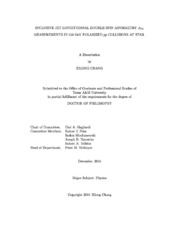| dc.description.abstract | With the early e - p deep inelastic scattering (DIS) measurements and the development
of Quantum Chromo-dynamics (QCD), the proton is revealed to be not just composed of the three quarks, u, u, and d, that give its quantum numbers, but also thousands of quark and anti-quark pairs and gluons that mediate the strong forces among quarks. The densities of partons - quarks, anti-quarks, and gluons – inside the proton are given by the parton distribution functions (PDFs). The PDFs are functions of the momentum fraction, x, carried by the partons within the proton and the scale, Q^2, at which the densities are probed.
In the longitudinally polarized lepton-nucleon and nucleon-nucleon scatterings, the polarized PDFs also depend on the spin orientation of the parton relative to the proton, like and unlike the proton spin, in addition to x and Q^2. The early polarized DIS experiments carried out by the EMC collaboration and later experiments at HERMES and COMPASS showed that the quarks inside the proton only contribute approximately 30% of the total proton spin. As proposed by the Jaffe-Manohar sum rule, the proton spin receives contributions not only from the quarks, but also from the gluons and from the orbital angular momentum of the quarks and gluons. This leaves an open question to further explore the gluon and orbital momentum contributions.
The Relativistic Heavy Ion Collider (RHIC) at Brookhaven National Laboratory is a facility that collides protons polarized in both longitudinal and transverse directions at energies up to √s = 510 GeV. The STAR and PHENIX detectors, located at two separate locations on the RHIC ring, can both provide useful constraints on the gluon distributions for x as low as 0.02. In particular, over the last decade STAR has constrained the gluon polarization with measurements of the longitudinal double-spin asymmetry, ALL, for inclusive jet production in √s = 200 GeV pp collisions. The results provide the first evidence, at the level of ~3o, that the gluons in the proton with x > 0.05 are polarized.
In this analysis, I perform the first ever measurement of ALL for inclusive jet production
in pp collisions at the higher beam energy of √s = 510 GeV, based on data that STAR recorded during 2012. The higher beam energy extends the sensitivity to gluon polarization down to x ~ 0.02. The high statistics of the data set and the small size of the physics asymmetries, compared to the previous measurements at 200 GeV, required the development of several new or improved analysis procedures in order to minimize the systematic uncertainties. These include: the first implementation by STAR of an underlying event subtraction during jet reconstruction, a much improved technique to estimate the trigger and reconstruction bias effects, a detailed optimization of the PYTHIA tune that provides a much better match between the experimental data and simulated Monte Carlo events, and a new procedure to estimate the uncertainties associated with the PYTHIA tune parameters.
The results for inclusive jet ALL vs. jet pT in 510 GeV pp collisions are presented. They are found to be consistent with predictions from recent global analyses of the polarized PDFs that included prior RHIC data in the fit. They are also consistent with the previous STAR inclusive jet ALL measurements at √s = 200 GeV in the region where the kinematics for the two beam energies overlap. These results will provide important new constraints on the gluon polarization in the proton in the x region below that sampled in 200 GeV pp collisions. | en |


